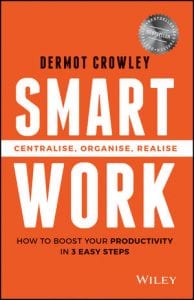 Crowley introduces his book with some comments about how we work in the 21st century, observing the following features:
Crowley introduces his book with some comments about how we work in the 21st century, observing the following features:
- Too much to do, too little time
- Information overload
- Still using outdated tools and strategies to organise work
- Senseless urgency
It is the last point that he sees as the real issue.
Crowley then introduces his “integrated productivity system” which he says sets out the steps and strategies to help you take control of how you organise and keep track of your incoming work (inputs), what you spend your time on each day (actions) and what you achieve (outcomes). In summary, the idea is to:
- Organise your inputs
Take a proactive approach to processing incoming work and create a connection between the inputs system and the actions system. - Centralise your actions
He sees centralisation as the key to effective action management. Having everything in one place gives you focus, clarity and improved ability to prioritise. - Realise your outcomes
This is about working not just efficiently, but effectively. To ensure we do the right things we need clarity of purpose and therefore we need space to stop doing and think about the bigger picture.
To maintain the integrated productivity system Cowley identifies three important habits – processing, planning and prioritising.
Processing is about managing the inputs and connecting them with your actions.
Planning is about the daily, weekly and monthly rituals to connection actions and outcomes. Monthly planning gives you perspective, weekly planning gets you organised and daily planning gets you focused.
The detail of his approach is split up into nine chapters as follows:
- Consolidate your work
Get all of your actions into one electronic organising tool - Schedule it forward
Both meetings and tasks need to be scheduled - Focus your day
Have a plan so you are less likely to be distracted - Reduce the noise
Get rid of non-essential stuff - Keep it simple
Tips for a better approach to email filing - Process to empty
How to have an empty email inbox at least once per week! - Identify your value
Identify which activities will have the biggest impact - Make time to plan
Daily, weekly and monthly planning routines - Fight for importance
Protect our own priorities from the different priorities of others
A few key things for me from this book
The notion of having a single place to record everything you need to do is a common theme of those who write on the topic. Crowley also pushes this idea. In my experience a critical part of this is getting stuff out of our head. That frees up our brain to focus on what we are doing now. Crowley has some good points on the use of technology here. In fact all the way through the book he has practical suggestions on how to use electronic tools. He refers to Outlook a lot but notes that most of what he talks about can apply equally to other tools.
I’ve always been a fan of folders for storing emails. Crowley presents a good case as to why less is more. As a result I have significantly reduced the number of folders I have. It’s a work in progress but I have made some progress and so far, so good.
Like many other writers, Crowley also presents a case for getting your email to zero – in his case on a weekly basis, and for reviewing emails only at certain times of the day so you can batch them. He acknowledges this might require resetting expectations with some people (like your clients!) so they do not expect instant responses.
Should you read this book?
Yes, is the short answer. It’s easy to read and contains a lot of practical ideas to help us work smarter.
